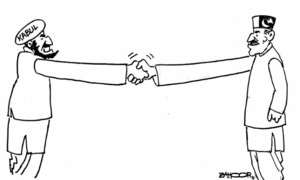KABUL: The head of the self-styled Islamic State group in the Afghanistan-Pakistan region has been killed in a drone strike in eastern Afghanistan, intelligence officials and militant leaders said on Saturday.
The National Directorate of Security (NDS), the Afghan spy agency, said Hafiz Saeed was among 30 IS-linked cadres killed in the strike in restive Nangarhar province, close to the Pakistani border, on Friday.
Two IS-affiliated leaders in Afghanistan who said they were present when the strike happened confirmed Saeed’s death.
The IS presence in Afghanistan is still thought to be at an embryonic stage and the killing of Saeed will come as a blow to the group’s efforts to establish itself as a serious force.
“Hafiz Saeed, ISIS leader in Afghanistan and Pakistan was killed in a drone strike last night,” the NDS said in a statement on Saturday.
“As a result of drone strike in Achin district on gathering place of Daesh, 30 people associated with Daesh including their leader Hafiz Seed were killed.”
Daesh is another name for IS.
The two militant leaders, who used to be with the Taliban, speaking to AFP by phone from an undisclosed location, said they were present when the drone strike happened.
The strike took place while a meeting of the IS leaders was going on, they said, adding that Saeed’s badly mutilated body was buried soon afterwards.
It comes less than six months after a drone strike in Afghanistan killed Abdul Rauf Khadim, who was thought to be the IS number two in the country.
On Monday, two US drone strikes in Achin targeted suspected IS militants, killing 49 people according to local officials.
A spokesman for US forces in Afghanistan confirmed a “precision strike” was carried out in Nangarhar on Friday but did not give details of the target. In one such strike Shahidullah Shahid, a Taliban member who had defected to IS, was eliminated.
Saeed was named head of IS’s “Khorasan province”, which includes Afghanistan, Pakistan and parts of neighbouring countries, in January when a group of Pakistani Taliban switched allegiance to the group.
Since then there have been defections from the Afghan Taliban, with some insurgents apparently adopting the IS flag to rebrand themselves as a more lethal force as Nato troops depart.
IS has grabbed large areas of Syria and Iraq in a brutal campaign but last month the Pentagon said the group’s presence in Afghanistan was still “in the initial exploratory phase”.
But their presence has clearly rattled the Taliban, who last month wrote to IS leader Abu Bakr al-Baghdadi warning against waging a parallel insurgency in Afghanistan.
Published in Dawn, July 12th, 2015
On a mobile phone? Get the Dawn Mobile App: Apple Store | Google Play












































